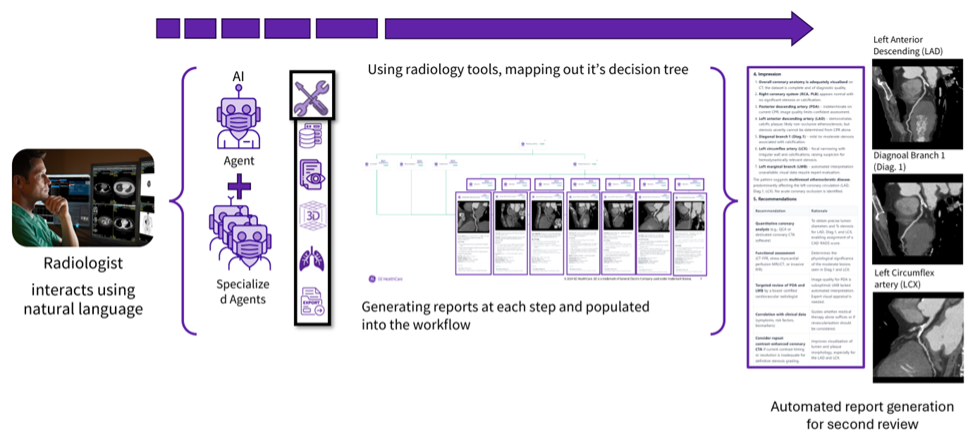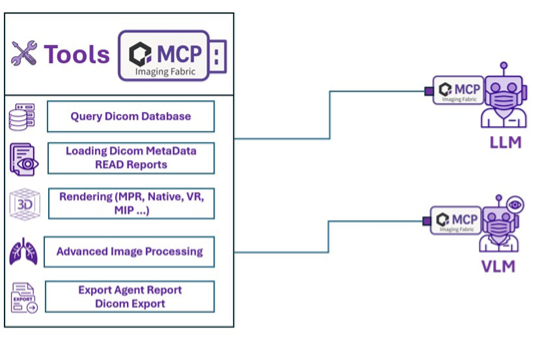Healthcare systems continue to face significant pressure with an estimated shortfall of 42,000 radiologists in the United States by 2033, alongside imaging study volumes increasing about 5 percent per year.1 This imbalance of workforce and demand highlights the need to research automation and decision-support methods that can help radiologists manage growing caseloads while maintaining diagnostic accuracy and patient care quality.
Visitors to the GE HealthCare experience area at HLTH 2025 will see a demonstration of research concepts exploring how agentic AI systems—built on Model Context Protocol (MCP) and GE HealthCare’s imaging framework—might one day assist diagnostic imaging workflows. When prompted with natural-language instructions such as “perform a coronary review,” the research prototype orchestrates multiple specialized AI agents that collaborate to complete simulated diagnostic tasks.
In these demonstrations, the system connects to GE HealthCare’s imaging framework, a modular set of components that spans the imaging workflow. For cardiac imaging scenarios, for example, the concept may reference the CT Cardiac Suite’s post-scan capabilities, which provide visualization and analysis tools. The AI agents automatically access imaging data through the framework’s loading services, apply rendering modes and interpolation techniques, and call cardiac-specific algorithms within a controlled research environment. The aim is to study whether a traditionally multi-step, manual workflow could be executed through a single, voice-driven command.2
Why Now: Model Context Protocol as a universal connector
Anthropic’s Model Context Protocol (MCP) represents an emerging interoperability standard that enables AI systems to share context and operate together more effectively. Similar to a translator at a medical conference, MCP allows specialized AI agents to exchange relevant patient and procedural information while preserving meaning and provenance.
Unlike conventional agents that operate independently, MCP establishes a shared context layer in which each AI agent can reference prior interactions, patient context, and diagnostic findings. The research explores whether this shared memory could create more cohesive, multi-agent reasoning similar to collaboration among clinical specialists.
By structuring and versioning contextual inputs, MCP also establishes a verifiable reasoning chain so that every output can be traced back to its originating data. This feature facilitates compliance, auditability, and governance in regulated domains such as healthcare. The protocol’s design aims to reduce integration complexity, support scalable automation, and enable auditable, enterprise-level adoption of AI technologies.3

The visualization framework
GE HealthCare researchers are studying a next-generation visualization and processing framework for medical-imaging application development. Its modular, service-oriented architecture is being designed for integration with MCP so that AI agents could connect with imaging tools, data streams, and diagnostic services within a governed environment.
The research framework combines three foundational elements:
- Imaging framework services – provide access, rendering, and interaction capabilities for medical images.
- Imaging cockpit – a dynamic workspace that brings together data selection, filtering, and application lifecycle management.
- Imaging developer resources – documentation, examples, and tutorials to help developers prototype imaging workflows efficiently.
Together, these components are being evaluated as an ecosystem that could allow developers to focus on innovation while aligning with regulatory and quality standards.
In practice, the concept demonstrates how reusable enablers can operate across the imaging workflow. The same batch and reformat components used in CT Digital’s Spine Auto Views and Head Auto Views can also be adapted for graphical prescription tasks during MR or CT scanning. A consistent approach ensures that data loading, rendering, interpolation, and export capabilities remain uniform across modalities.
With a standards-first mindset, this concept aligns with DICOM and recognized software-engineering principles to support interoperability. The codebase follows GE HealthCare’s Quality Management System (QMS) standards and produces auditable documentation that could facilitate regulatory alignment.

How Agentic AI could transform the imaging pipeline
Combining MCP with the modular imaging framework may enable a more connected imaging pipeline. Instead of relying on separate workflow managers, diagnostic viewers, and reporting tools, future systems under study could dynamically interact through AI agents that adapt to changing clinical data.
In these experiments, patient demographics, prior studies, and imaging metadata persist across workflow stages, reducing redundancy and helping ensure continuity. Each AI action is logged with parameters and timestamps, producing immutable audit trails that strengthen governance and traceability. Structured reasoning traces and automatically generated report drafts are conceptualized to be reviewed by radiologists for validation, maintaining clinical oversight.
The research aims to evaluate whether this model can improve efficiency, consistency, and diagnostic confidence by creating adaptive, context-aware imaging workflows. Radiologists could be supported by assistants capable of prioritizing studies, pre-processing4 data, or preparing structured draft reports, while developers gain the ability to prototype imaging applications using natural-language descriptions.5
Expected research impacts on clinical practice
Early findings suggest that integrating MCP with the imaging framework may help design more adaptive and patient-centered workflows. Radiologists could benefit from intelligent assistants that anticipate workflow needs—prioritizing patient lists, compiling histories, and drafting structured reports—while final interpretation and responsibility remain entirely with the clinician.
For developers, this same architecture could allow natural-language descriptions of imaging tasks to generate auditable pipelines automatically. This capability has the potential to accelerate creation of specialized imaging tools without compromising clinical rigor.
The ongoing research presented in GE HealthCare’s HLTH 2025 experience area examines how AI-driven architectures might reshape medical-imaging workflows. By uniting MCP’s shared-context capabilities with modular imaging infrastructure, GE HealthCare aims to explore new ways to enhance efficiency, strengthen diagnostic confidence, and align technology innovation with clinical outcomes.
- https://thisweekhealth.com/news_story/radiologist-shortage-threatens-timely-healthcare-amid-rising-demand/ ↩︎
- All innoivations presented throughout this article are concept only. May never become a product. Not for sale. Not cleared or approved by the U.S. FDA or any other global regulator for commercial availability. ↩︎
- Concept only. May never become a product. Not for sale. Not cleared or approved by the U.S. FDA or any other global regulator for commercial availability ↩︎
- Concept only. May never become a product. Not for sale. Not cleared or approved by the U.S. FDA or any other global regulator for commercial availabilityConcept only. May never become a product. Not for sale. Not cleared or approved by the U.S. FDA or any other global regulator for commercial availabilityConcept only. May never become a product. Not for sale. Not cleared or approved by the U.S. FDA or any other global regulator for commercial availability ↩︎
- Concept only. May never become a product. Not for sale. Not cleared or approved by the U.S. FDA or any other global regulator for commercial availability ↩︎

